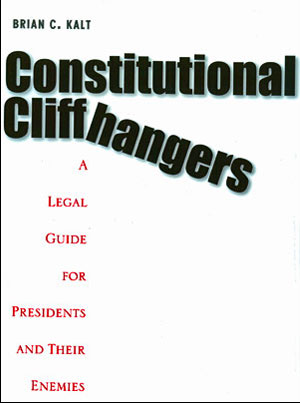
Constitutional Cliffhangers is about six situations in which the Constitution’s provisions for selecting, replacing, and punishing presidents are seriously vulnerable.
Each chapter starts out with a fictional scenario that dramatizes one situation of danger. The chapter then discusses the legal and practical angles that the players would fight over in the ensuing drama. Interspersed in that discussion, I have further snippets from the fictional scenario. By the end of the chapter, the reader has an idea of how that chapter’s “cliffhanger” could arise, how it might “sound” as it happened, how it would play out politically and legally, and what (if anything) we might do to prevent it.
In Chapter 4, for instance, the vice presidency is vacant and the president is killed, which touches off a succession dispute between the Speaker of the House and the secretary of state. There are serious constitutional problems with having the Speaker in the line of succession, and the chapter shows how the facts on the ground could lead to a power struggle. In an ordinary situation, the Speaker would take over and there would be no controversy, but if things are just so, we could have a disaster on our hands.
Bookending the six cliffhangers are two chapters that look for deeper meaning in all of this. For instance, the intersection of law and politics is very interesting to me. So many of these intricate legal questions would turn not on the best legal analysis but on which side is in a stronger political posture. That has significant implications for constitutional interpretation and design.
My first task, though, is to convince the reader that these things are worth worrying about. Historically, these sorts of situations—or near misses—happen all the time. When they do, we abuse hindsight and say, in retrospect, that it was obvious that it would happen; that it was obvious what the proper resolution would be; and that it is all fixed now, leaving us with nothing to worry about. And then the next thing happens, and the pattern repeats. I try to break through that complacency and figure out when and how these traps get created, and when and how we step in them.
My hope is that thinking about these things in advance can help. In some cases, we might be able to fix things to avoid the problem. Congress could simply amend the succession law, for instance. In other cases, there isn’t much hope for anyone fixing the problem in advance. Here I think that perhaps my book might at least be useful in the middle of a crisis. That’s why the subtitle is “A Legal Guide for Presidents and Their Enemies.”
For more general readers, I want them to enjoy the drama in each chapter as they learn about the legal issues. Prosecuting sitting presidents, two-term presidents sneaking back into office—such issues are just too much fun to leave to the lawyers.
This book came from a combination of two streams.
The first is my interest in constitutional oddities. When I was a law student, we were discussing presidential pardons and I asked the professor (Akhil Reed Amar) whether a president could pardon himself. He said that I should research the question and write it up. I did, and that was my first legal publication. I also wrote something with Professor Amar on prosecuting presidents, and later I looked into the question of impeaching people after they’d left office.
Soon after that, coincidentally, speculation began swirling about President Clinton pardoning himself. Criminal charges against him loomed. Then, on his last day in office, Clinton pardoned Marc Rich and Senator Specter talked about impeaching Clinton even though he had left office. I started to think of these sorts of questions as not just interesting, but also potentially relevant.
The second stream in my professional life emerged out of a very different strand of my scholarship. I formulated a theory under which there is a 50-square-mile swath of Idaho where you can commit crimes with impunity. I wanted to get Congress to fix the loophole, and I thought that I had a good chance—my theory made sense, legally, and it attracted a fair amount of attention in the media and elsewhere.
Two very frustrating things happened, though. The first was that I could not get anyone in Congress to acknowledge me, let alone respond to the problem I had identified. (Eventually they did acknowledge me, after C.J. Box wrote a best-selling novel, Free Fire, that used my theory. They did not, however, take any action.)
The second frustrating thing was that whenever I presented my theory, people would say “they wouldn’t just let criminals go free; they’d find some way to convict them.” My response was that that was not an answer. It was not a legal argument. And yet, when a real case did arise, the trial court rejected my argument by saying—in no more detail than this—that while my reading of the Constitution was literally correct, it couldn’t be right because it would mean letting the defendant go free. Then, the prosecutors kept the defendant from appealing the issue. In other words, the people who said “they’ll find a way” were right. (The loophole is still out there, undeterred by that judge’s cursory consideration, and encouraged by the prosecutors’ apparent fear of an appeal.)
That got me thinking much more deeply about what it really takes for a legal argument to prevail. If I’m writing (as I do in Chapter 4) about a power struggle between the Speaker of the House and the secretary of state, it is not sufficient for me to simply set out the legal arguments and pick the one I think is best. I need to take stock of all of the factors that would affect the outcome, of which the strength of the legal arguments is, at most, one.
I think that the six scenarios in my book are all compelling and dramatic. I hope that they draw the reader in, and inspire him or her to delve into the legal and political discussion in the remainder of the chapter.
Here is an excerpt of what I already mentioned—part of the opening scenario to Chapter 4, in which the Speaker of the House and the secretary of state are both claiming the presidency:
As President Lewis arrives at a public event one morning, an assassin detonates a huge bomb, killing the president and dozens of others. In a homemade video produced before the assassination, the bomber decries “the coward Lewis” and announces his intention to kill Lewis so that the stalwart Wilton will become president and continue the war. Within two hours of the assassination, the video has saturated television and the Internet.
The assassin seemingly gets his wish. Wilton condemns the assassination in the most strident terms, obviously, but she takes an oath of office that morning as acting president. Her political position is tenuous. Supporters of the martyred President Lewis blame Speaker Wilton for fueling the rhetoric that led to Lewis’s assassination, and for her role in stalling to keep the vice presidency vacant. In other words, they feel as though the country has just suffered a coup d’état. They latch onto a legal argument that, just hours earlier, had been an academic one: that it is unconstitutional for the succession law to include members of Congress. Wilton’s opponents argue—with the support of several prominent legal experts—that the dovish secretary of state, John Allen, is the legitimate acting president.
Secretary Allen decides to contest Wilton’s claim to the presidency. He too takes an oath of office as acting president and, without using force, he assumes physical control of the White House. “The struggle over our war policy has been ugly, but it’s a political struggle,” he says in a national address from the Oval Office. “In America, we don’t settle political questions by mass murder.”
It has only been ten hours since the assassination—a shocking and surreal day. No violence has broken out yet, but it feels like only a matter of time before it does. No one is in the mood to compromise, and control of the government and the military hangs in the balance as Allen and Wilton vie for control.
I do think that it is likely that one of the scenarios in my book, or at least something close to it, will happen over the next few decades. If any ever does, I hope that my book will help the country to find a constructive way to navigate the situation.
I also hope that my book will encourage Congress and the president to think more carefully about these sorts of situations, and to fix the things that are worth fixing. There are plenty of simple steps that can be taken to reduce the risk.
I hope that my book encourages people to look beyond their own personal favorite constitutional theories, and take stock of other approaches. I hope that I can help legal theorists better appreciate the limits of legal theory in dealing with political questions. At the same time, though, I hope that I can help political theorists appreciate the importance of legal theories in these same situations.
Finally, I hope that Constitutional Cliffhangers makes structural constitutional-law issues interesting to a general audience.


Brian C. Kalt is a professor of law and the Harold Norris Faculty Scholar at Michigan State University. Before coming to MSU, he served as a law clerk for the Honorable Danny J. Boggs, and worked at the Washington D.C. office of Sidley and Austin. Professor Kalt earned his bachelor’s degree from the University of Michigan, and his juris doctor from Yale Law School, where he was an editor of the Yale Law Journal.